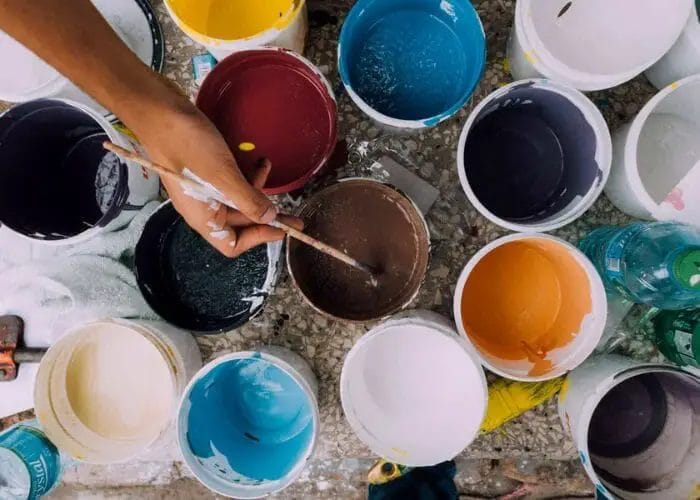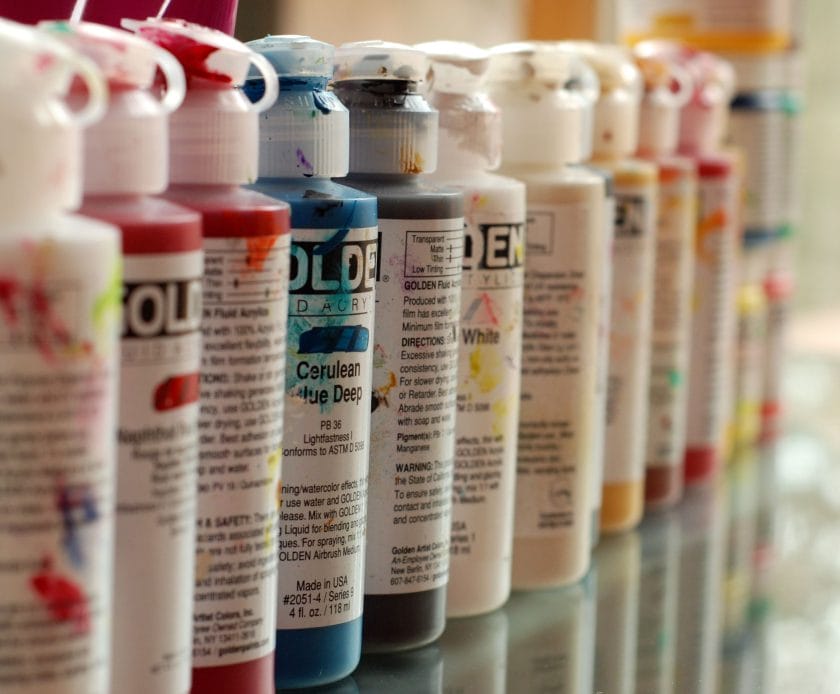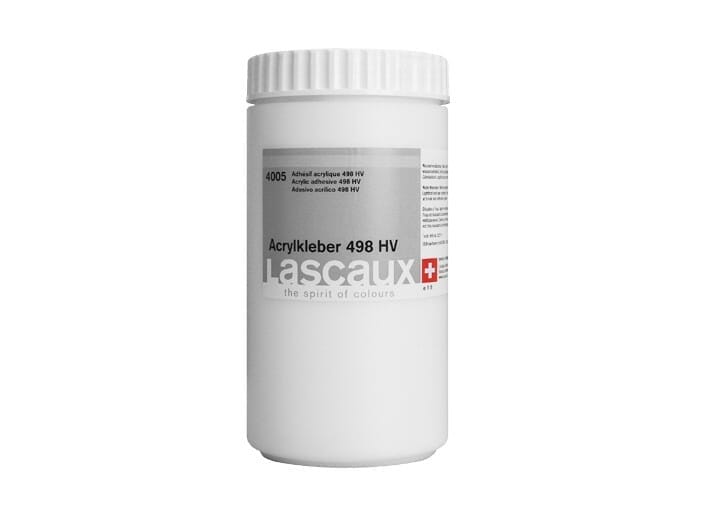Acrylic paint is not water-soluble by nature, as it is composed of synthetic polymers that create a durable and water-resistant finish once dry. However, there are acrylic paints available that are water-based and can be thinned and cleaned up with water.
These water-based acrylic paints offer the same vibrant colors and versatility as traditional acrylics but with the added benefit of easy water clean-up.
Whether you prefer the traditional or water-based version, acrylic paint provides a versatile and long-lasting option for artists of all levels.

Understanding Acrylic Paints: Water Solubility Explained
In this section, we will delve deeper into the concept of water solubility in acrylic paints and explore its implications for artists.
What is water solubility in acrylic paints?
Water solubility refers to the ability of a substance to dissolve in water. In the case of acrylic paints, water solubility means that the paint can be thinned or diluted with water. This property offers artists greater control over the consistency and transparency of their paint, allowing for a wide range of techniques and effects.
Advantages of water solubility in acrylic paints
The water solubility of acrylic paints brings several advantages to artists:
- Easy clean-up: Unlike oil paints, which require solvents for cleaning brushes and palettes, acrylic paints can be easily cleaned with water. This makes the painting process more convenient and reduces exposure to potentially harmful chemicals.
- Layering and glazing: By diluting acrylic paints with water, artists can create transparent layers and glazes. This technique allows for the build-up of depth and complexity in paintings.
- Blending and gradation: Water solubility enables smooth blending of colors and the creation of gradients. Artists can achieve seamless transitions from one color to another, enhancing the overall visual appeal of their artwork.
- Texturing: When mixed with water, acrylic paints can be used to create interesting textures and effects. Artists can achieve a range of textures, from smooth and glossy to rough and matte.
Working with water-soluble acrylic paints
When using water-soluble acrylic paints, it is important to keep a few tips in mind:
- Start with small amounts of water: Begin by adding small increments of water to the paint until the desired consistency is achieved. It is easier to add more water if needed than to remove excess water.
- Use a palette: A palette provides a surface for mixing and diluting the paint. It also helps to keep the colors separate and organized, allowing for easier color mixing.
- Experiment with different ratios: Explore the effects of different water-to-paint ratios to create varying levels of transparency and opacity. This experimentation will help develop a personal style and achieve desired visual effects.
- Consider the drying time: Water-soluble acrylic paints tend to dry faster than traditional acrylic paints. Take this into account when working on your artwork and plan accordingly.
In summary, the water solubility of acrylic paints offers artists a range of possibilities for creative expression. By understanding and harnessing the power of water solubility, artists can explore different techniques, achieve desired effects, and create visually captivating artwork. Whether you are a professional artist or a beginner, experimenting with water-soluble acrylic paints can open up new avenues for artistic exploration.
The Properties of Acrylic Paints: Solubility and Versatility
Acrylic paints have gained immense popularity in the world of art due to their unique properties of solubility and versatility. Artists of all skill levels, from beginners to professionals, find acrylic paints to be a versatile medium that allows for a wide range of artistic expressions.
Solubility:
One of the key properties of acrylic paints is their solubility. Unlike oil paints, which require solvents such as turpentine or mineral spirits for thinning and cleaning brushes, acrylic paints can be easily diluted with water. This makes them a preferred choice for artists who prefer a water-based medium.
The solubility of acrylic paints allows artists to achieve different levels of transparency and opacity by adding varying amounts of water. By diluting the paint, artists can create translucent washes or glazes, which can be layered to build up depth and luminosity in their artwork. On the other hand, using undiluted acrylic paint straight from the tube provides vibrant, opaque colors, perfect for bold and expressive brushwork.
Additionally, the solubility of acrylic paints enables artists to experiment with different techniques, such as wet-on-wet blending, glazing, or scumbling. This versatility allows for a wide range of artistic styles and effects, from smooth and realistic renderings to bold and abstract compositions.
Versatility:
Another remarkable property of acrylic paints is their versatility. These paints can be used on a variety of surfaces, including canvas, wood, paper, fabric, and even glass or metal. They adhere well to most surfaces, ensuring that the artwork remains intact for years to come.
Acrylic paints also dry relatively quickly compared to oils, allowing artists to work at a faster pace. This is particularly advantageous for artists who prefer to work in layers or enjoy the spontaneous nature of the medium. With acrylics, artists can quickly build up layers of paint or add additional details without having to wait extended periods for the paint to dry.
Additionally, acrylic paints are known for their permanence and durability. Once dry, they become water-resistant, making the artwork less prone to damage from moisture or humidity. The colors also tend to retain their vibrancy over time, ensuring that the artwork remains visually appealing for years to come.
Furthermore, acrylic paints offer a wide range of finishes, from matte to high gloss, allowing artists to choose the desired effect for their artwork. The various finishes add depth and dimension to the painting, enhancing its overall aesthetic appeal.
In summary, acrylic paints possess unique properties of solubility and versatility, making them a preferred choice for artists worldwide. The ability to dilute with water and experiment with different techniques allows for a wide range of artistic expressions, while the versatility to be used on various surfaces and the quick drying time make acrylics an ideal medium for artists of all skill levels.
Exploring the Water Solubility of Acrylics: Pros and Cons
Acrylic paint is a popular choice among artists due to its versatility and vibrant colors. Traditionally, acrylic paints are water-resistant once they dry, which means they cannot be easily dissolved or cleaned up with water. However, with advancements in technology, water-soluble acrylic paints have emerged as a viable alternative. In this section, we will explore the pros and cons of water-soluble acrylics.
Pros of Water-Soluble Acrylics
1. Easy Cleanup: One of the main advantages of water-soluble acrylics is that they can be easily cleaned up with water. Unlike traditional acrylics that require solvents like turpentine or mineral spirits for cleanup, water-soluble acrylics can be rinsed off brushes, palettes, and other painting tools using water.
2. Reduced Toxicity: Solvent-based acrylic paints can emit strong fumes that may be harmful if inhaled or ingested. Water-soluble acrylics, on the other hand, have lower levels of volatile organic compounds (VOCs) and are generally considered to be less toxic. This makes them a safer option for artists who are sensitive to fumes or concerned about their health.
3. Extended Working Time: Water-soluble acrylics have a longer drying time compared to traditional acrylics. This allows artists to work with the paint for a longer period, making it easier to blend colors or create subtle transitions. The extended working time can be especially beneficial for artists who prefer working on larger and more complex artworks.
4. Mixing with Water: Unlike traditional acrylics that require mediums for thinning and extending, water-soluble acrylics can be easily mixed with water to achieve desired consistency and effects. The ability to dilute the paint with water opens up a wide range of techniques, such as watercolor-like washes or transparent glazes.
5. Easy Re-Activation: If you make a mistake or want to make changes to your artwork, water-soluble acrylics can be re-activated with water even after they have dried. This allows for corrections or layering without the risk of damaging the underlying layers.
Cons of Water-Soluble Acrylics
1. Less Vibrant Colors: One drawback of water-soluble acrylics is that the colors may appear slightly less vibrant compared to traditional acrylics. This is because the water-soluble formulation affects the pigments’ intensity to some extent. However, for most artists, the slight difference in color intensity is not a significant concern.
2. Texture and Opacity: Water-soluble acrylics have a slightly different texture and opacity compared to traditional acrylics. Some artists may find that water-soluble acrylics have a more translucent quality, which can affect the ability to achieve thick, opaque layers. However, this can also be viewed as an advantage for those who prefer a more transparent and layered approach to their artwork.
3. Drying Time: While extended drying time can be an advantage, it can also be a disadvantage for artists who prefer quick-drying paints. Water-soluble acrylics generally take longer to dry, especially when used in thicker applications. Artists who work on tight deadlines or require fast drying times may find this aspect less desirable.
4. Binding Medium: Water-soluble acrylics require a binding medium to improve adhesion and durability, especially when used on non-absorbent surfaces like glass or plastic. While this may add an extra step to the painting process, it ensures that the paint adheres effectively and remains long-lasting.
5. Sensitivity to Moisture: Water-soluble acrylics can be sensitive to moisture, both during the painting process and after the artwork is complete. If not properly sealed or protected, the paint can re-activate or become susceptible to water damage. Artists using water-soluble acrylics should take precautions to ensure the longevity of their artwork.
In summary, water-soluble acrylics offer a range of benefits such as easy cleanup, reduced toxicity, extended working time, and the ability to mix with water. However, they may have slightly less vibrant colors, a different texture and opacity, longer drying times, and require a binding medium for certain surfaces. Artists should consider their specific needs and preferences when deciding whether to use water
Water-Mixable Acrylics: A Soluble Alternative to Traditional Acrylic Paints
Acrylic paints are widely popular among artists due to their versatility and vibrant colors. However, working with traditional acrylic paints can be challenging, especially when it comes to cleaning brushes and tools. Fortunately, there is a solution to this problem – water-mixable acrylics.
1. What are Water-Mixable Acrylics?
Water-mixable acrylics, also known as water-soluble or water-based acrylics, are a type of acrylic paint that can be diluted and cleaned up with water. Unlike traditional acrylics, which require the use of toxic solvents like turpentine or mineral spirits, water-mixable acrylics can be thinned and cleaned easily with just water.
2. How Do Water-Mixable Acrylics Work?
Water-mixable acrylics consist of pigments suspended in an acrylic polymer emulsion, similar to traditional acrylic paints. The difference lies in the emulsifying agents used, which allow the paint to mix and react with water. As a result, artists can achieve various effects by manipulating the paint’s consistency and flow.
3. Advantages of Water-Mixable Acrylics
Using water-mixable acrylics offers several advantages for artists:
- Non-Toxic: Water-mixable acrylics are a safer alternative to traditional acrylics as they eliminate the need for toxic solvents. This makes them ideal for artists working in small spaces or those with sensitivities to chemicals.
- Easy Cleanup: Cleaning brushes and tools after using water-mixable acrylics is a breeze. Simply rinse them with water and mild soap, avoiding the need for harsh solvents.
- Versatility: Just like traditional acrylics, water-mixable acrylics can be used on a variety of surfaces, including canvas, paper, wood, and more. They can also be combined with other mediums.
- Fast Drying: Water-mixable acrylics dry relatively quickly, allowing artists to layer and work on their paintings without much waiting time.
- Color Mixing: Artists can achieve a wide range of colors by mixing water-mixable acrylics just like traditional acrylics. Experimenting with different color combinations is both fun and rewarding.
- Environmentally Friendly: Since water can be used for thinning and cleaning water-mixable acrylics, the environmental impact is reduced compared to traditional acrylic paints that require toxic solvents.
4. Tips for Working with Water-Mixable Acrylics
To make the most out of your water-mixable acrylic painting experience, here are some tips to keep in mind:
- Use a palette with airtight compartments to keep the paint moist for longer periods.
- Experiment with different ratios of paint to water to achieve desired transparency and consistency.
- Consider using mediums specifically formulated for water-mixable acrylics to enhance the paint’s characteristics.
- Apply thin layers and allow them to dry before adding more paint to avoid muddiness and cracking.
- Clean brushes immediately after use to prevent the paint from drying and damaging the bristles.
- Store water-mixable acrylic paintings in a dry place away from direct sunlight to prevent fading and discoloration.
5. Conclusion
In summary, water-mixable acrylics are an excellent alternative to traditional acrylic paints. They offer the same versatility and vibrancy but with the added advantage of easy cleanup and reduced exposure to toxic solvents. Water-mixable acrylics are a great choice for artists of all skill levels who value convenience, safety, and environmental consciousness.
Tips and Techniques for Using Water Soluble Acrylic Paints
Water soluble acrylic paints have gained popularity among artists due to their versatility, vibrant colors, and ease of use. Whether you are a beginner or an experienced artist, there are several tips and techniques that can help you master the art of using water soluble acrylic paints. In this section, we will explore some of these tips and techniques to enhance your painting skills.
1. Prepare Your Surface
Before you start painting with water soluble acrylics, it is essential to prepare your surface properly. Make sure your canvas or paper is clean and free from any dust or debris. You can also consider applying a thin layer of gesso to create a smooth and even surface, which will improve the adhesion and durability of the paint.
2. Use a Wet Palette
A wet palette can be a game-changer when using water soluble acrylic paints. It helps to keep your paints moist and workable for a longer duration. You can either purchase a pre-made wet palette or create one by placing a damp sponge or paper towel at the bottom of a shallow container and covering it with a piece of parchment paper. This will prevent your paints from drying out too quickly.
3. Experiment with Water Ratios
Water soluble acrylic paints can be diluted with water to achieve different effects. By varying the water ratios, you can create transparent washes or build up layers of opaque colors. Experiment with different amounts of water to find the consistency that works best for your desired effect. Remember, the more water you add, the more transparent the paint becomes.
4. Work Quickly
Unlike traditional acrylic paints, water soluble acrylics tend to dry faster. Therefore, it is important to work quickly and efficiently to blend and mix colors on your canvas. One technique to extend the working time is to mist your palette and paints with water regularly or use a stay-wet palette to keep the paints moist.
5. Explore Different Techniques
Water soluble acrylic paints offer a wide range of techniques that you can explore to create unique effects in your artwork. Some popular techniques include:
- Wet-on-wet: Apply wet paint onto a wet surface to create soft and blended edges.
- Dry brushing: Use a dry brush to apply paint thinly and create texture.
- Glazing: Layer transparent washes of paint over dry layers to create depth and luminosity.
- Sgraffito: Scratch into the wet paint layers to reveal underlying colors or textures.
6. Clean your Brushes and Palettes
Proper brush and palette maintenance is essential when working with water soluble acrylic paints. Rinse your brushes thoroughly with water after each painting session and reshape the bristles to prevent them from becoming frayed. Clean your palettes and mixing surfaces promptly to avoid dried paint buildup.
7. Experiment and Have Fun!
Don’t be afraid to experiment and try new techniques with water soluble acrylic paints. Explore different color combinations, layering methods, and tools to create unique and captivating artwork. Remember, the journey of artistic expression should be enjoyable, so embrace the process and let your creativity flow.
In summary, water soluble acrylic paints provide artists with a versatile and vibrant medium to explore their creativity. By preparing your surface, using a wet palette, experimenting with water ratios, working quickly, exploring different techniques, cleaning your brushes and palettes, and embracing experimentation, you can unlock the full potential of water soluble acrylic paints and create stunning works of art.

Is acrylic water soluble?
No, acrylic paint is not water soluble once it dries. It forms a permanent and waterproof layer once it has fully cured. However, while it is still wet, acrylic paint can be easily diluted and cleaned up with water.

Conclusion:
In conclusion, acrylic paint is not water soluble once it dries. Unlike watercolors, which can be reactivated and blended even after drying, acrylics form a permanent layer on the surface. This characteristic makes them an ideal choice for various art applications, such as canvas painting, mural creation, and mixed media projects.
Acrylic paints offer a wide range of vibrant colors, excellent coverage, and durability. They can be used on various surfaces, including canvas, paper, wood, and even fabric. Additionally, their quick drying time allows artists to layer and build textures in a relatively short span of time.
Overall, acrylic paint is a versatile and popular medium among artists due to its water resistance and versatility, making it suitable for both beginner and professional artists alike.
